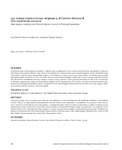Mostrar o rexistro simple do ítem
Las nuevas construcciones religiosas y el Concilio Vaticano II: una experiencia personal
| dc.contributor.author | Chávez de la Mora, Gabriel | |
| dc.date.accessioned | 2019-05-31T06:40:30Z | |
| dc.date.available | 2019-05-31T06:40:30Z | |
| dc.date.issued | 2005 | |
| dc.identifier.citation | Chávez de la Mora, F. G. (2017). Las nuevas construcciones religiosas y el Concilio Vaticano II. Actas De Arquitectura Religiosa Contemporánea, 4, 232-251. https://doi.org/10.17979/aarc.2015.4.0.5137 | es_ES |
| dc.identifier.issn | 2340-5503 | |
| dc.identifier.uri | http://hdl.handle.net/2183/23093 | |
| dc.description.abstract | [Resumen] El presente texto ofrece algunos principios y criterios para la realización de las nuevas construcciones que deberán cobijar las actividades de la Iglesia Católica. Hay una enorme variedad de construcciones que necesita la Iglesia, desde catedrales hasta cementerios. Para los fines del presente análisis, me centraré en el tema de una parroquia urbana. Considero que el centro parroquial podría considerarse como un centro de promoción humana integral, puesto que toma en cuenta todas las actividades del hombre considerado de forma integral: «cuerpo, alma y espíritu», como propone san Pablo en 1Tes 5:23. El tratamiento del tema, lógicamente, exige un enfoque tanto religioso como arquitectónico. Por lo tanto, el análisis está estructurado a partir de la metodología del arquitecto; pero cada paso de esta metodología se fundamenta en la visión de fe que origina y alienta la construcción de cualquier centro parroquial. | es_ES |
| dc.description.abstract | [Abstract] This text provides some principles and criteria for the realization of new buildings that will shelter the activities of the Catholic Church. There is a huge variety of buildings that need the Church, from cathedrals to cemeteries. For purposes of this discussion, I will focus on the theme of an urban parish. I consider the parish center could be considered as a center of integral human development, since it takes into account all human activities considered holistically «body, soul and spirit», as proposed by St. Paul in 1Thess 5:23. The treatment of the subject, of course, requires both a religious and architectural approach. Therefore, the analysis is structured from the methodology of the architect, but every step of this methodology is based on the vision of faith that creates and encourages the construction of any parish center. | es_ES |
| dc.language.iso | spa | es_ES |
| dc.publisher | Universidade da Coruña | es_ES |
| dc.relation.uri | https://doi.org/10.17979/aarc.2015.4.0.5137 | es_ES |
| dc.rights | Atribución-NoComercial 4.0 España | es_ES |
| dc.rights.uri | http://creativecommons.org/licenses/by-nc/3.0/es/ | * |
| dc.subject | Arquitectura religiosa | es_ES |
| dc.subject | Concilio Vaticano II | es_ES |
| dc.subject | Fray Gabriel Chávez de la Mora | es_ES |
| dc.subject | Centro parroquial | es_ES |
| dc.subject | Liturgia | es_ES |
| dc.subject | Sacred architecture | es_ES |
| dc.subject | Second Vatican Council | es_ES |
| dc.subject | Parish center | es_ES |
| dc.subject | Liturgy | es_ES |
| dc.title | Las nuevas construcciones religiosas y el Concilio Vaticano II: una experiencia personal | es_ES |
| dc.title.alternative | New religious buildings and Second Vatican Council: A Personal Experience | es_ES |
| dc.type | info:eu-repo/semantics/article | es_ES |
| dc.rights.access | info:eu-repo/semantics/openAccess | es_ES |
| UDC.journalTitle | Actas de Arquitectura Religiosa Contemporánea | es_ES |
| UDC.issue | 4 | es_ES |
| UDC.startPage | 232 | es_ES |
| UDC.endPage | 251 | es_ES |






